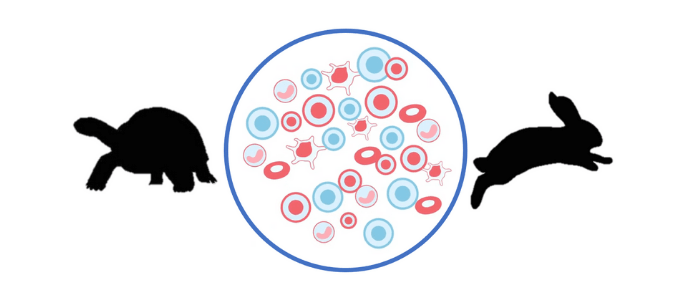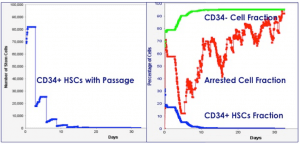New from Asymmetrex: TORTOISE Test™ and RABBIT Count™ technologies

Analytical and rapid stem cell counting through computing
Every tissue stem cell scientist knows that for many years it has been impossible to determine the specific number of any tissue stem cell type. Rapid and sensitive flow cytometry lacks the specific biomarkers that are necessary. Expensive, long and complicated SCID mouse repopulating cell assays provide unreliable estimates that are limited to hematopoietic stem cells (HSCs). Colony forming unit assays, though an industry standard for cord blood banking, do not give HSC-specific dosage or predict HSC potency.
Asymmetrex’s (MA, USA) new TORTOISE Test™ and RABBIT Count™ tissue stem cell counting technologies provide the first convenient tools for routine and specific counting of tissue stem cells in complex experimental, cell manufacturing and stem cell treatment preparations. Now, every tissue stem cell scientist can determine the specific number of any tissue stem cell type, including HSCs from all sources, mesenchymal stem cells and stem cells in all perinatal and postnatal tissues.
<< CLICK HERE TO TAKE THE SURVEY >>
 TORTOISE Test: a tool for tissue stem cell-specific kinetics analyses
TORTOISE Test: a tool for tissue stem cell-specific kinetics analyses
In a recent issue of OBM Transplantation [1], Asymmetrex scientists reported their development of a patented [2,3] computational simulation software platform (TORTOISE Test) that quantifies the number of tissue stem cells in complex tissue cell preparations based on cell culture proliferation kinetics. Shown below in Table 1 are examples of the specific stem cell counts determined for commonly studied tissue stem cell preparations.
| Table 1. Tissue stem cell numbers determined with the TORTOISE Test. | |
| Stem cell type | Stem cell number (95% confidence; per 10,000 total cells) |
| Bone marrow (CD34+) | 2.6 (2.0–3.2) |
| Cord blood (CD34+) | 24 (18–30) |
| Lung | 420 (120–720) |
| Liver | 812 (200–1420) |
| Mesenchymal – amnion | 3.1 (1.4–4.8) |
| Mesenchymal – bone marrow | 4.6 (2.9–6.3) |
In addition to determining the tissue stem cell fraction of any starting tissue cell preparation, the TORTOISE Test software has many other unique capabilities underneath its shell. It also provides for the first time the ability to quantify kinetic properties of tissue stem cells selectively without confounding with their ever present and more abundant progeny, committed progenitor cells. Figure 1 shows how, in addition to detecting changes in tissue stem cell number with cell culture passage, the TORTOISE Test software can delineate between the kinetics of tissue stem cells, transiently amplifying cells and arrested differentiated cells in the same cell culture. The software also provides specific outputs for tissue stem cell viability and self-renewal kinetics [1]. These analyses are powerful new tools for investigating tissue stem cell function in response to agents like drug candidates and in relation to specific cellular mechanisms of interest.

Figure 1. TORTOISE Test™ analysis of HSCs and other important cell types in serial cultures of human CD34+ cord blood cells.
 RABBIT Count: a tool for routine rapid tissue stem cell counting
RABBIT Count: a tool for routine rapid tissue stem cell counting
The TORTOISE Test is Asymmetrex’s solution for in-depth analysis of many different types of tissue stem cells. Using the unique data output of the TORTOISE Test software, Asymmetrex recently discovered the existence of mathematical algorithms that can be used to rapidly determine the stem cell-specific fraction (SCF) of any complex tissue cell preparation based on the preparation’s cell population doubling time (PDT) [1]. Asymmetrex is now developing a suite of tissue stem cell type-specific PDT:SCF determination algorithms, which constitute Asymmetrex’s new RABBIT Count platform.
Table 2 shows that the RABBIT Count algorithms deliver rapid tissue stem cell counts with the same accuracy as the TORTOISE Test software. Routine rapid determination of the tissue SCF has many important applications. In addition to regular use for tissue and cell research, RABBIT Count algorithms are ideal for inline monitoring of tissue stem cell number during cell and tissue manufacturing process development and for pharma and biopharma evaluations of the effects of drug candidates on tissue stem cell health and function.
| Table 2. Comparison of cord blood HSC fraction determined by TORTOISE Test and RABBIT Count. | ||
| TORTOISE Test† | RABBIT Count† | |
| Trial A | 35 ± 15 (16–54) | 44 ± 3 (37–51) |
| Trial B | 30 ± 17 (9–51) | 72 ± 13 (40–104) |
| †Mean ± SD per 10,000 MNCs (95% CI). | ||
To begin counting and analyzing tissue stem cells with the TORTOISE Test and RABBIT Count technology platforms visit: https://bit.ly/FreeStemCellCount today.
[1] Dutton R, Abdi F, Minnetyan L, Sherley JL. A computational technology for specific counting of perinatal and postnatal Human tissue stem cells for transplantation medicine. OBM Transplantation 4(3), 24 (2020) (Special issue cover story).
[2] Sherley JL: US9733236B2 (2017).
[3] Sherley JL: GB2529921A (2019).